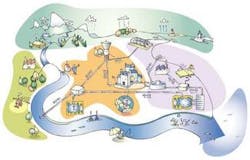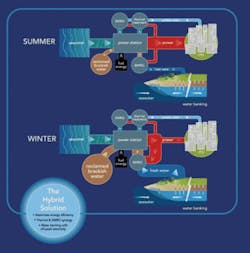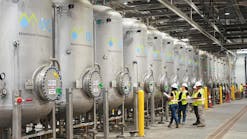Converting off peak electricity in hybrid power generation plants into valuable fresh groundwater for future use translates into energy storage, contends Bruce Durham of Veolia Water, a specialist on alternative water resources, and Anthony Bennett of Specialist Technical Solutions.
The "hybridisation" of power generation systems is being seriously investigated to discover how power stations can improve efficiency by using unused power generation capacity to increase valuable freshwater production when sufficient demand or storage is available.
Figure 1. Hydrological cycle
Excess freshwater produced can then be "banked" for future use to increase the security of supply during droughts or disasters. Converting off peak electricity into valuable fresh groundwater for future use is equivalent to energy storage, an approach that increases process efficiency by taking advantage of the synergy between strengths and weaknesses of different process solutions. This strategy is one of several alternative water cycle management options that are currently being investigated by water supply specialists.
Regulators and water producers, who manage and control water consumption throughout the hydrological cycle, are giving high priority to increasing water availability by maximising water management efficiency through the reduction of waste, demand, leakage and evaporation.
Reclaimed water is used for indirect potable applications, ultrapure processes and high purity water applications in manufacturing, industry or power generation. Seawater desalination normally makes up the deficit at high cost where consumption is in excess of available water.
Important opportunities for increasing environmental sustainability are overlooked because the benefits of water reuse are not well understood. The hydrological cycle must be managed, but potable water quality and wastewater treatment for environmental protection are mistakenly avoided as if they were unrelated subjects.
A potable supply that satisfies appropriate quality standards must be available to maintain water security during drought, other natural disasters and terrorist attacks. Sustainable water is required to meet today's needs without jeopardising the ability to meet the needs of future generations. Affordable water is essential for local economic development.
The hydrological cycle can be viewed at three scales: large, medium and small cycles. The large cycle refers to the geographical cycle of evaporation, precipitation, surface and groundwater systems. The medium cycle includes the collection, treatment and use of potable water; and the treatment of wastewater for direct surface water recharge or indirect groundwater recharge. Often called unplanned reuse, this cycle discourages discussion about water sources and reinforces the separation of potable and wastewater management. The small cycle is defined as the planned collection and treatment of wastewater so that it can be carefully treated locally and supplied directly and safely to the consumer.
Water availability
Regular precipitation is required in most parts of the world to satisfy potable water requirements. In many areas, historical records for droughts and floods have been broken almost every year over the last ten years. Increased urbanisation and risks to the supply of imported water reduce the availability of potable water. Hence, regular precipitation or imported sources or water cannot always be relied upon.
The Mediterranean climate regions of Australia have set targets to achieve 20% reuse of wastewater by 2012. Targets in arid regions are set at 50% to 100% reuse and Australian government subsidies are available at 50% of capital cost for municipal schemes.
Figure 2. Stored energy
Many countries with similar climates and economies have embraced reuse for industrial applications, saline ingress control, groundwater recharge and irrigation. This trend has resulted in an increase in the water volume used for reuse projects of 25% to 60% per year over the last five years. This compares with desalination growth of approximately 17% per year in the most active regions. Reuse projects have helped local economies develop more robust and flexible water management strategies. Experience and technological developments are building export business and providing solutions needed to respond to climate change.
Water reuse is of fundamental importance to environment and economy. Benefits are numerous and include reduced aqueous pollution into receiving waters and retention of high quality water for potable supply. Reuse links the large water cycle and the smaller local water cycle together and can be used as a catalyst to help understand the hydrological cycle as a whole.
Future needs
Lower water production cost on reuse and desalination projects is the key issue to increasing water availability. Energy costs are usually the largest contribution to cost (25% to 40%) due to the physical weight of water and the need to remove dissolved impurities from water via membrane or thermal systems.
Hybridisation can increase process efficiency by taking advantage of the synergy between the strengths and weaknesses of different process solutions. These solutions can include competing technologies such as thermal and membrane desalination techniques.
One approach that is being studied is how to increase the efficiency of power generation systems by reducing the inefficient, off peak, low power demand period. This unused power generation capacity could be used to increase valuable freshwater production if there is sufficient demand or storage.
Groundwater storage, also referred to as water banking, is attracting much interest as more water is consumed by evaporation from reservoirs globally than the volume of water used by man. New freshwater storage aquifers are being used extensively in the USA for freshwater banking. Water banking can increase the security of supply during droughts or disasters. It could be argued that converting off peak electricity into valuable fresh groundwater for future use is equivalent to energy storage.
This type of hybrid solution could include using large water re-purification systems to produce freshwater to control over-abstraction of groundwater and seawater ingress control, as practised in several parts of the USA for more than 20 years. In the Orange County Water District in Southern California (www.ocwd.com), high quality water reclaimed from treated wastewater has been injected into groundwater since 1976.
OCWD chose recycled water because, in addition to economic advantages, environmental benefits included —
- reduction of wastewater discharged to sea;
- reduction of dependency on surface water supplies;
- constant availability of reclaimed water supply.
The initial "Water Factory 21" product water was a blend of five million gallons per day (mgd) reverse osmosis (RO) treated water, nine mgd carbon adsorption-treated water, and 8.6 mgd deep well water. This blend, with a maximum total dissolved solids (TDS) content of 500 mg/l, met all California Department of Health Services primary and secondary drinking water standards, in addition to complying with the injection requirements of the California Regional Water Quality Control Board in the Santa Ana region.
Currently, OCWD is constructing the Groundwater Replenishment System (GWRS) at Fountain Valley, California, an advanced membrane purification facility that will provide 70 mgd treated water using three steps of purification — microfiltration, RO and UV withhydrogen peroxide — to provide treated water of similar quality to Water Factory 21. The treated water will be used to expand the existing underground seawater intrusion barrier and recharge the groundwater basin. Half of the water produced will be injected into the seawater intrusion barrier and the remainder will be sent through a 13-mile pipeline to percolation ponds in Anaheim, California, where it will naturally percolate into the groundwater basin.
The GWRS will provide a new drought-proof water source for OCWD, reducing reliance on imported water. Additionally, the GWRS will save additional funds in the future by improving the quality of the water in the Orange County groundwater basin. The project is expected to use about half the energy compared to the alternative of importing water.
Over-abstraction of groundwater and seawater ingress is a global problem, seriously threatening food production capacity. Groundwater supplies an estimated 10% of global water demand.
Increasing the performance efficiency of process systems provides obvious economic benefits. Membrane processes, such as RO, are subject to fouling, which increases power demand and other operating costs, and reduces treated water output; therefore decreasing and efficiently managing the rate of fouling will reduce costs.
Pre-treatment technologies must be improved. Novel coagulants can be used along with efficient high-rate settling, flotation, microfiltration (MF) or ultrafiltration systems to optimise downstream RO operations and minimise fouling. The development of effective pre-treatment is a clear priority.
Finally, lessons from past failures have shown the critical importance of operating issues such as training, maintenance, and having detailed operating procedures with contingency plans. Advanced modelling and control strategies, and the development of robust but efficient operating decision support tools based on data processing, will contribute greatly to reducing the technical and economic risks of future reuse, desalination and zero liquid discharge systems.
Authors' Note
Bruce Durham is the manager of the alternative water resource projects at Veolia Water. For more information, contact by Email: bruce.durham@ veoliawater.com or visit www.veoliawater.com
Anthony Bennett, managing and technical director of Specialist Technical Solutions Limited, can be reached by E-mail: [email protected].




